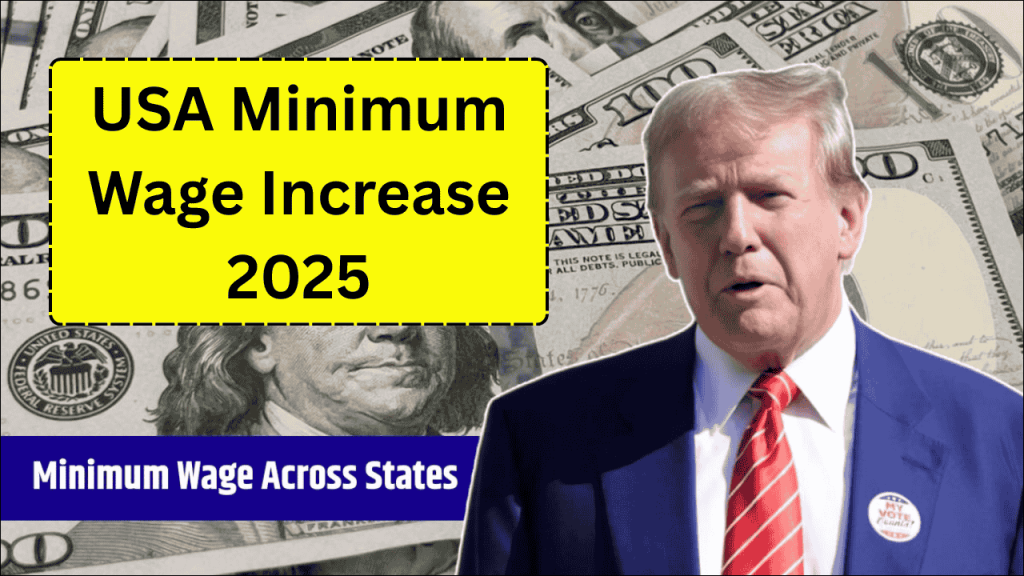
As the economic landscape continues to evolve across the United States in 2025, minimum wage policies remain predominantly driven by state and local initiatives rather than federal action. While the federal minimum wage holds steady at $7.25 per hour—unchanged since 2009—states and municipalities have implemented a patchwork of higher wage standards to address rising costs of living, inflation concerns, and growing calls for livable wages.
This comprehensive analysis examines the current minimum wage rates across the country as of May 2025, explores the economic impacts of these changes, and provides essential information for both workers and employers navigating this complex regulatory environment.
Current State of Minimum Wages (May 2025)
The minimum wage landscape in 2025 reflects significant regional variations, with the highest hourly rates concentrated in coastal states and major metropolitan areas. Most wage increases have been implemented through one of three mechanisms: scheduled legislative increases, inflation-based adjustments, or public ballot initiatives.
State Minimum Wage Rates (May 2025)
The following table provides current minimum wage rates for states across the country, highlighting recent changes and special provisions:
| State | Standard Minimum Wage | Tipped Minimum Wage | Annual Adjustment Mechanism | Recent or Upcoming Changes |
|---|---|---|---|---|
| Alabama | $7.25 (Federal) | $2.13 | None | No state minimum wage law |
| Alaska | $11.73 | $11.73 | CPI Adjustment | Increased from $11.15 in January 2025 |
| Arizona | $14.70 | $11.70 | CPI Adjustment | Adjusted for inflation January 2025 |
| Arkansas | $13.00 | $3.63 | Scheduled Increase | Final step of 2022 ballot measure |
| California | $16.50 | $16.50 | CPI Adjustment | Fast food: $20.70; Healthcare: $25.00 |
| Colorado | $15.68 | $12.33 | CPI Adjustment | Denver: $18.29 |
| Connecticut | $16.35 | $6.38 | Scheduled Increase | Final scheduled increase from 2023 law |
| Delaware | $13.25 | $2.63 | Scheduled Increase | Reached final scheduled rate in 2024 |
| Florida | $14.00 | $11.00 | Scheduled Increase | $15.00 effective Sept 30, 2026 |
| Georgia | $7.25 (Federal) | $2.13 | None | State minimum: $5.15 (Federal applies) |
| Hawaii | $14.00 | $14.00 | Scheduled Increase | $16.00 scheduled for 2026 |
| Idaho | $7.25 (Federal) | $3.35 | None | No state increases planned |
| Illinois | $15.00 | $9.00 | Potential CPI | Chicago: $16.70 |
| Indiana | $7.25 (Federal) | $2.13 | None | No state increases planned |
| Iowa | $7.25 (Federal) | $4.35 | None | Some counties have higher local rates |
| Kansas | $7.25 (Federal) | $2.13 | None | No state increases planned |
| Kentucky | $7.25 (Federal) | $2.13 | None | Louisville: $12.65 |
| Louisiana | $7.25 (Federal) | $2.13 | None | No state minimum wage law |
| Maine | $14.15 | $7.08 | CPI Adjustment | Portland: $15.60 |
| Maryland | $15.00 | $4.00 | CPI Adjustment | Montgomery County: $16.90 |
| Massachusetts | $16.00 | $6.75 | Scheduled Increase | Final step of 2023 wage law |
| Michigan | $12.75 | $4.59 | CPI Adjustment | Limited to 3.5% annual increase |
| Minnesota | $10.85 | $10.85 | CPI Adjustment | Large employers: $15.50 |
| Mississippi | $7.25 (Federal) | $2.13 | None | No state minimum wage law |
| Missouri | $13.00 | $6.50 | CPI Adjustment | St. Louis: $15.00 |
Note: Table shows selected states. For complete information, visit your state’s Department of Labor website.
Official Government Resources
For authoritative information on minimum wage laws and worker rights, consult these official government resources:
| Agency | Resource | Purpose | Official Link |
|---|---|---|---|
| U.S. Department of Labor | Federal Minimum Wage Laws | Information on federal wage standards | DOL Minimum Wage |
| U.S. Department of Labor | State Minimum Wage Laws | Comprehensive map of state wage laws | State Minimum Wage Laws |
| California DIR | CA Wage Orders | California-specific wage regulations | CA Wage Orders |
| New York DOL | NY Wage Standards | NY minimum wage information | NY Minimum Wage |
| Florida DEO | Florida Minimum Wage | FL wage increase schedule | FL Minimum Wage |
| Illinois DOL | Illinois Minimum Wage | IL wage requirements | IL Minimum Wage Law |
Economic Impact of Regional Wage Variations
The wide disparity in minimum wages across states—ranging from $7.25 to over $16.50 per hour—has created distinct regional economic effects. Research and economic data from 2025 highlight several important trends:
Employment Effects
Contrary to some predictions, states with higher minimum wages have not experienced catastrophic job losses. Instead, the employment landscape shows nuanced outcomes:
- Reduced turnover: Businesses in higher-wage states report 15-20% lower employee turnover rates
- Sector shifts: Some labor-intensive industries have seen modest reductions in workforce size, offset by growth in other sectors
- Automation acceleration: Higher wage areas show faster adoption of automation technologies, particularly in food service and retail
- Youth employment: Data suggests slightly lower employment rates for teenage workers in states with the highest minimum wages
Business Adaptations
Businesses have employed various strategies to manage increased labor costs:
- Price adjustments: Average menu price increases of 2-4% in restaurant sectors
- Schedule optimization: More precise staffing based on customer demand patterns
- Benefit restructuring: Some reduction in optional benefits, though core benefits remain stable
- Productivity enhancements: Investment in training and efficiency improvements
Worker Economic Outcomes
For minimum wage workers, the economic impacts include:
- Reduced reliance on public assistance: States with $15+ minimum wages show 8-12% decreases in SNAP enrollment
- Housing stability: Lower eviction rates and housing insecurity among minimum wage workers
- Consumption patterns: Increased spending on healthcare, education, and durable goods
- Debt reduction: Modest improvements in consumer debt levels and credit scores
Special Wage Provisions by Industry
Beyond the standard minimum wage, several states have implemented industry-specific wage standards that exceed their general minimum wage:
Healthcare Worker Wages
California and New York have pioneered higher minimum wages for healthcare workers:
- California: $25.00 per hour for healthcare workers
- New York: $22.50 per hour for hospitals in NYC, $20.00 elsewhere in state
- Washington: $19.50 for hospital staff
These healthcare-specific wages aim to address critical staffing shortages and recognize the essential nature of these positions.
Fast Food Industry
California’s landmark fast food minimum wage law continues to draw national attention:
- Current rate: $20.70 per hour (as of May 2025)
- Applies to chains with 60+ locations nationally
- Includes annual inflation adjustment mechanism
- Established Fast Food Council to recommend future standards
Other states are considering similar sector-specific approaches, with legislation pending in New York, Illinois, and Washington.
Tipped Wage Considerations
The treatment of tipped employees remains one of the most complex aspects of minimum wage policy. Three distinct models exist as of 2025:
- No tip credit states: Seven states require the full minimum wage for tipped workers (AK, CA, MN, MT, NV, OR, WA)
- High base wage states: Eleven states require more than 50% of the standard minimum wage for tipped workers
- Federal model states: Remaining states follow or closely align with the federal $2.13 tipped minimum
For tipped workers, the regulatory landscape includes these key protections:
- Employers must ensure tips plus base wages equal or exceed the standard minimum wage
- Tip pooling regulations vary significantly by state
- Some states have implemented tip declaration standards and verification requirements
Compliance Challenges for Multi-State Employers
Businesses operating across state lines face particular challenges navigating the complex minimum wage environment:
- Payroll system complexity: Programming different rates by location and job category
- Training requirements: Ensuring managers understand different regional requirements
- Documentation needs: Maintaining appropriate records to demonstrate compliance
- Policy inconsistencies: Balancing internal equity with legal compliance across jurisdictions
Many national employers have responded by implementing company-wide minimum wages that exceed local requirements, simplifying compliance while enhancing recruitment and retention.
Future Outlook: Wage Trends Beyond 2025
Several emerging trends suggest the direction of minimum wage policies in the coming years:
- Continued state leadership: With federal action unlikely, states will continue driving wage policy
- Sector-specific approaches: More industries may see targeted wage standards based on economic conditions
- Automation considerations: Policy discussions increasingly acknowledge technological displacement concerns
- Benefit integration: Some jurisdictions are exploring combining wage standards with benefit requirements
- Regional coordination: Neighboring states are beginning to coordinate wage policies to minimize border effects
Economists project that by 2027, more than 30 states will have minimum wages of $15 or higher, representing a dramatic shift from just a decade earlier.
Worker Rights and Reporting Violations
Workers who believe they are not receiving proper wages have several options for recourse:
- Document the issue: Keep detailed records of hours worked and wages received
- Address with employer: Discuss concerns with management or HR
- File a complaint: Contact state labor department or federal Wage and Hour Division
- Seek legal advice: Consult with employment attorney or legal aid organization
Most wage laws prohibit retaliation against workers who assert their rights to proper compensation.
Conclusion
The minimum wage landscape in 2025 reflects America’s federalist approach to labor policy, with states and localities implementing standards tailored to their economic conditions and political priorities. While this creates complexity for multi-state employers, it also serves as a laboratory for policy innovation, providing valuable data on the economic effects of different wage approaches.
As inflation and cost-of-living concerns persist, wage policies will remain a central economic issue. Workers, employers, and policymakers must stay informed about these evolving standards and understand both the rights and responsibilities they create.
FAQs
Does the federal minimum wage override state minimum wages? No, workers are entitled to the higher of the two rates – when state minimum wage exceeds the federal $7.25, the state rate applies.
Are all workers entitled to receive minimum wage? No, certain exemptions exist for specific categories including some students, independent contractors, and certain disabled workers.
How often do minimum wages typically increase? States with inflation-linked minimum wages adjust annually, usually in January, while others follow schedules set by legislation.
If I work across multiple minimum wage jurisdictions, which rate applies? You must be paid the applicable minimum wage for the location where you physically perform your work.

Isabell Johnson is a passionate writer known for captivating stories that blend imagination and reality. Inspired by travel, history, and everyday moments, She crafts narratives that resonate deeply with readers.




